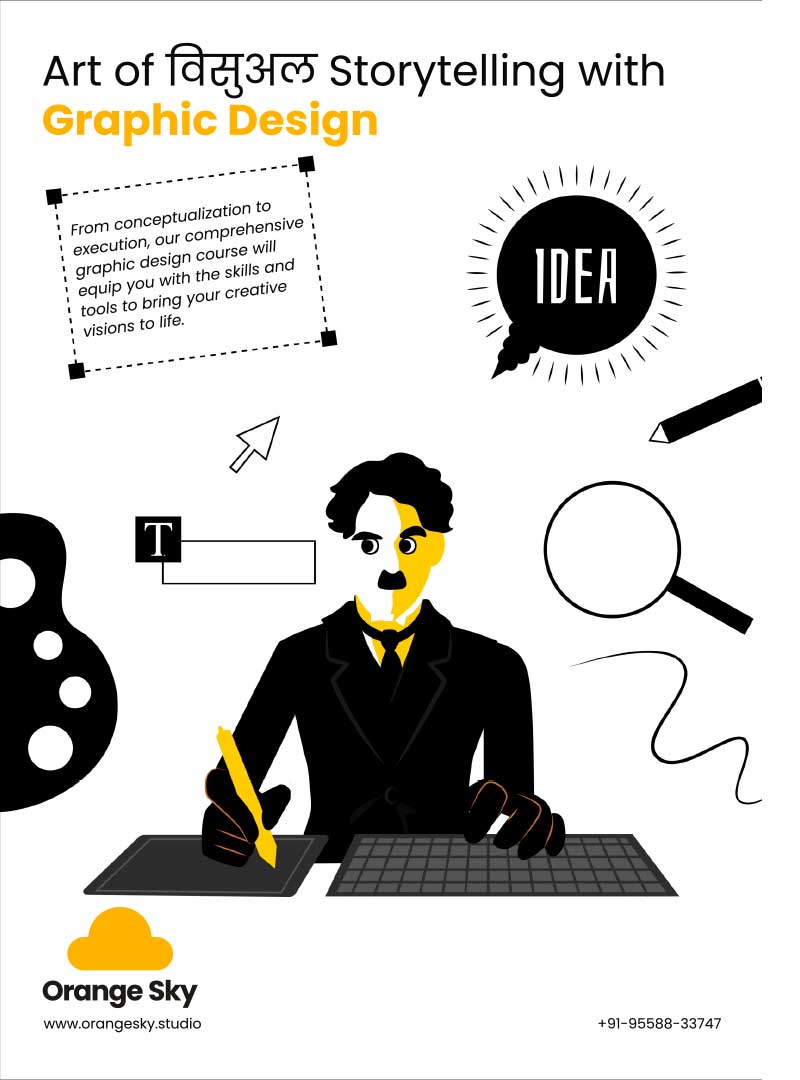
Course Language : Hindi, English | Course Media : Offline
Throughout the course, students will explore the fundamental principles of graphic design, including typography, color theory, composition, and layout. They will also learn how to use industry-standard design software such as Adobe Photoshop, Illustrator, and Canva gaining hands-on experience in creating various design projects.
There are no specific prerequisites for this course. However, basic computer literacy and familiarity with internet usage are recommended. No prior designing experience is required as the course covers Graphic Design concepts from scratch.
In addition to technical skills, the course emphasizes the development of critical thinking and problem-solving abilities. Students will learn how to analyze design briefs, conduct research, generate ideas, and iterate on their designs based on feedback and critique. They will also explore the importance of understanding target audiences and designing with usability and accessibility in mind.
The course covers a wide range of design disciplines, including branding, logo design, print design, digital design, and web design. Students will learn how to conceptualize and execute design projects that effectively communicate messages, evoke emotions, and engage audiences. They will also dive into the process of creating visually cohesive and aesthetically pleasing designs that align with clients' needs and brand identities.
• Understanding the Photoshop interface and workspace
• Exploring essential tools and panels
• Navigating and customizing the workspace
Week 1
• Importing and organizing images
• Cropping, resizing, and straightening images
• Working with layers and layer masks
• Using basic selection tools
Week 1
• Adjusting brightness, contrast, and color balance
• Using adjustment layers for non-destructive editing
• Removing blemishes and imperfections
• Retouching techniques for portraits
Week 2
• Advanced selection tools and techniques
• Refining selections and working with Quick Mask
• Creating and using layer masks effectively
• Selective adjustments and compositing
Week 3
• Adding and formatting text layers
• Working with character and paragraph styles
• Creating text effects and applying typography principles
• Designing with type hierarchy
Week 4
• Understanding design principles and composition
• Layout creation and grid systems
• Working with shapes and vector paths
• Designing for print and digital media
Week 5
• Working with advanced retouching tools
• HDR processing and panorama stitching
• Smart objects and non-destructive editing
• Batch processing and automation
Week 6
• Optimizing images for web and mobile devices
• Creating banners, buttons, and web graphics
• Designing graphics for social media platforms
• Exporting assets for web and digital use
Week 7
• Applying learned skills to a comprehensive project
• Reviewing best practices for portfolio presentation
• Tips for career advancement and freelance opportunities
Week 8
• Familiarize yourself with the Illustrator workspace and interface
• Understand vector graphics and their advantages over raster graphics
• Learn about file formats, resolutions, and color modes in Illustrator
Week 9
• Create and modify basic shapes, lines, and curves
• Master the Pen tool for precise path creation and editing
• Combine shapes and apply fills, strokes, and gradients
Week 9
• Understand the concept of objects and their attributes
• Organize artwork using layers and layer management techniques
• Apply transformations, alignment, and distribution to objects
Week 10
• Create and format text using the Type tool
• Apply character and paragraph formatting options
• Design logos, posters, and typographic elements using Illustrator's text capabilities
Week 11
• Navigate the Canva interface and understand its features
• Discover the various design types and templates available
• Learn about the different elements of a Canva design
Week 12
• Utilize text, shapes, and illustrations to enhance your designs
• Apply colors, gradients, and transparency effects
• Work with layers to organize and edit design elements
Week 12
• Personalize pre-designed templates to match your style and brand
• Customize layouts, fonts, and color schemes
• Import and edit images to create unique visuals
Week 12
• Explore advanced features like grids, frames, and advanced text formatting
• Understand design principles and composition techniques
• Optimize designs for different platforms and formats
Week 12
• You enrolled to work in Live Projects for 1 month
1 Month
Q: What is graphic design?
?
A: Graphic design is the art of visually communicating ideas and messages through typography, images, colors, and layout techniques.
Q: Who can enroll in a graphic design course?
A: Anyone interested in graphic design, including beginners, aspiring designers, professionals seeking to enhance their skills, or individuals looking for a creative outlet.
Q: What will I learn in a graphic design course?
A: You will learn design principles, typography, color theory, layout design, image editing, logo design, branding, and how to use design software like Adobe Photoshop, Illustrator, and Canva.
Q: What equipment or software do I need for a graphic design course?
A: You will typically need a computer or laptop with design software installed, such as Adobe Photoshop, Illustrator and Canva.
Q: What career opportunities are available after completing a graphic design course?
A: Completing a graphic design course can open doors to various career paths, including graphic designer, web designer, UI/UX designer, branding specialist, art director, and freelancer.
Q: Will I receive a certificate upon completing the course?
A: Yes.
Q: Can I continue learning and expanding my Graphic Design skills after completing the course?
A: Absolutely! Graphic Design is a continuously evolving field, and the course serves as a solid foundation for further learning. You can explore advanced topics, frameworks, and technologies to enhance your skills and stay up-to-date with industry trends.